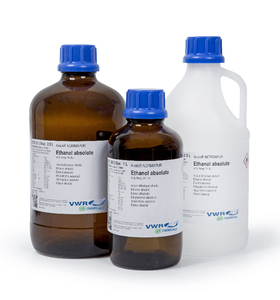VWR Iodine trichloride (Wijs'reagent) for determination of iodine value
Catalog No :
CAS Number :
Brand :
In Stock
Specifications:
| Storage Temperature | Ambient | ||
| Product Type | Laboratory Chemical | Forms | Liquid |
| Product Brand | VWR | ||
| Product Grade | Analytical grade | Formula | ICl₃ |
VWR Iodine Trichloride (Wijs’ Reagent) is a specialized reagent solution used for the determination of iodine value (IV) in fats, oils, and fatty acids, a critical measure of unsaturation. This reagent is a stabilized solution of iodine monochloride (ICl) or iodine trichloride (ICl₃) in glacial acetic acid, formulated to react quantitatively with the carbon-carbon double bonds present in unsaturated fatty acids.
The Wijs method, which uses this reagent, is a widely accepted standard protocol outlined by AOCS, ISO, and ASTM for determining the degree of unsaturation in edible and industrial oils.
Key Features
- High Reactivity: Ensures rapid and complete halogenation of double bonds in fatty acids.
- Stabilized Solution: Prepared in glacial acetic acid to maintain oxidative strength and shelf life.
- Analytical Grade: Suitable for routine laboratory determinations in food, cosmetic, and chemical industries.
- Conforms to Standard Methods: Compatible with ISO 3961, AOCS Cd 1-25, and ASTM D1959 methods for iodine value analysis.
Applications and Use Cases
1. Determination of Iodine Value (IV) in Oils and Fats
-
Used to quantify the degree of unsaturation in:
- Edible oils (olive, sunflower, soybean, etc.)
- Animal fats and lards
- Biodiesel and industrial oils
- Higher iodine value indicates more double bonds (higher unsaturation), which affects stability, shelf life, and reactivity.
2. Quality Control in Food and Cosmetic Manufacturing
- Helps assess oxidative stability and drying properties of raw materials.
- Used in formulation development and regulatory compliance testing.
3. Biodiesel Feedstock Analysis
- Assesses feedstock unsaturation which influences fuel performance.
- Important for monitoring compliance with biodiesel standards (e.g., EN 14214, ASTM D6751).
Standard Procedure (Simplified Wijs Method)
-
Sample Preparation
- Dissolve a known weight (~0.2–0.5 g) of the fat or oil sample in chloroform or carbon tetrachloride in a glass-stoppered iodine flask.
-
Addition of Wijs Reagent
- Add an excess of iodine trichloride solution (Wijs' reagent) to the sample under controlled conditions and mix well.
-
Reaction Time
- Allow the mixture to stand in the dark at room temperature for 30–60 minutes (depending on the method and expected IV).
-
Titration
- Add potassium iodide solution to release free iodine.
- Titrate with standard sodium thiosulfate solution until the yellow color almost disappears.
- Add starch indicator and continue titrating until the solution turns colorless.
-
Blank Correction
- Perform a parallel blank determination (without the sample) to correct for reagent background.
-
Calculation
- Calculate the iodine value (IV) using the difference between blank and sample titration volumes:

Where:
- B = volume of thiosulfate for blank (mL)
- S = volume of thiosulfate for sample (mL)
- N = normality of thiosulfate solution
- 12.69 = constant derived from molecular weight of iodine
Safety and Handling
| Hazards | Details |
|---|---|
| Chemical Hazards | Corrosive, oxidizing; may cause burns or respiratory irritation |
| Personal Protection | Use gloves, lab coat, eye protection; work in fume hood |
| Incompatibilities | Avoid contact with strong bases, metals, reducing agents |
| Storage | Store in tightly closed container, away from light and heat |
Always refer to the Safety Data Sheet (SDS) for full handling and disposal guidance.
Unique Advantages of VWR Iodine Trichloride (Wijs’ Reagent)
- Ready-to-use formulation saves preparation time and improves repeatability.
- Reliable performance in routine and regulated analytical settings.
- Compatible with multiple standard protocols, ensuring regulatory and methodological alignment.
- Available in multiple volumes to suit lab-scale or high-throughput environments.
For laboratory use only. Not for drug, food, or household use.
- Pack Size: 1L 500 mL




 0
0
